Semester 2 Exam
1/198
Earn XP
Description and Tags
Mr. Schreiber, Honors Biology 2025
Name | Mastery | Learn | Test | Matching | Spaced |
|---|
No study sessions yet.
199 Terms
Stages of Cellular Respiration:
Glycolysis, Pyruvate Oxidation, Krebs cycle, Electron Transport Chain.
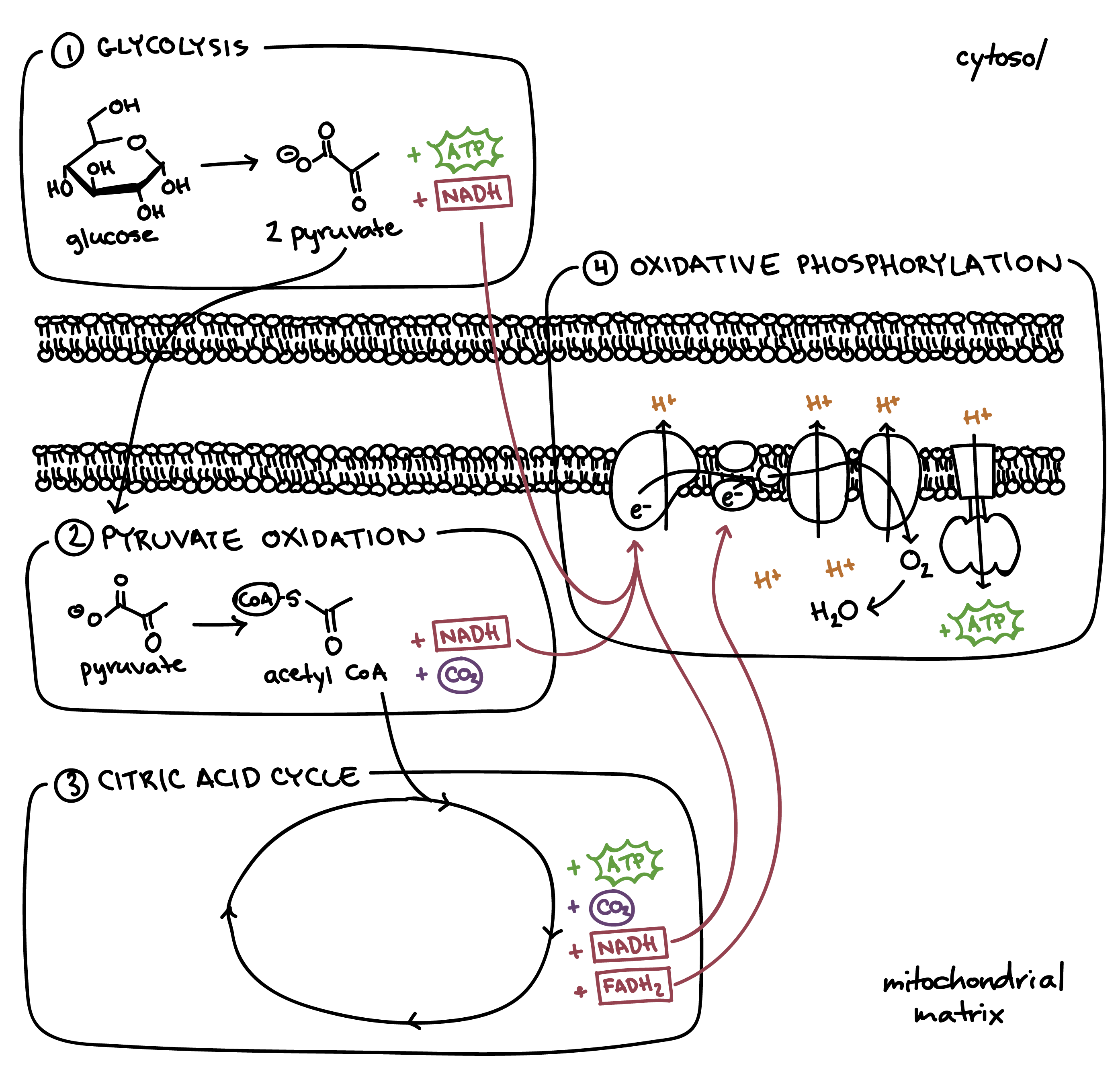
Explain why cells require energy
Perform essential functions like synthesis, active transport, movement, and maintaining order
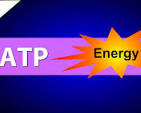
Describe the relationship between photosynthesis and cellular respiration
Photosynthesis in plants produces oxygen and glucose using sunlight. Cellular Respiration in animals then uses that oxygen and glucose to produce energy, releasing carbon dioxide and water, which are then used again by plants in photosynthesis. The cycle continues.
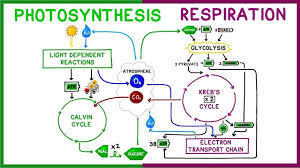
Write the overall balanced equation for cellular respiration.
C6H12O + 6CO -> 6CO + 6H O + energy
6 2 2 2

Explain how breathing (respiration) is related to cellular respiration.
Breathing creates oxygen that is used by ur cells to produce energy in a process called cellular respiration. Then the waste product carbon dioxide is breathed out.
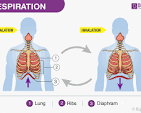
Explain how redox reactions are involved in cellular respiration
Redox reactions play a central role in cellular respiration by transferring electrons to release energy through oxidation and reduction. These electron transfers occur via electron carriers like NAD⁺ and FAD+, which become NADH and FADH₂. These carriers transport the electrons to the electron transport chain, where energy is used to produce ATP.
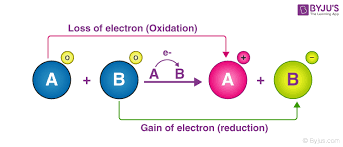
Oxidation
Glucose is oxidized, meaning it loses electrons (and hydrogen atoms), breaking it down into carbon dioxide
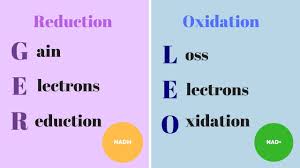
Reduction
Oxygen is reduced, meaning it gains electrons (and hydrogen atoms), forming water
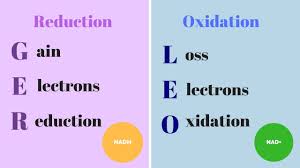
glycolysis
process by which glucose is broken down into pyruvate, producing a small amount of ATP and NADH
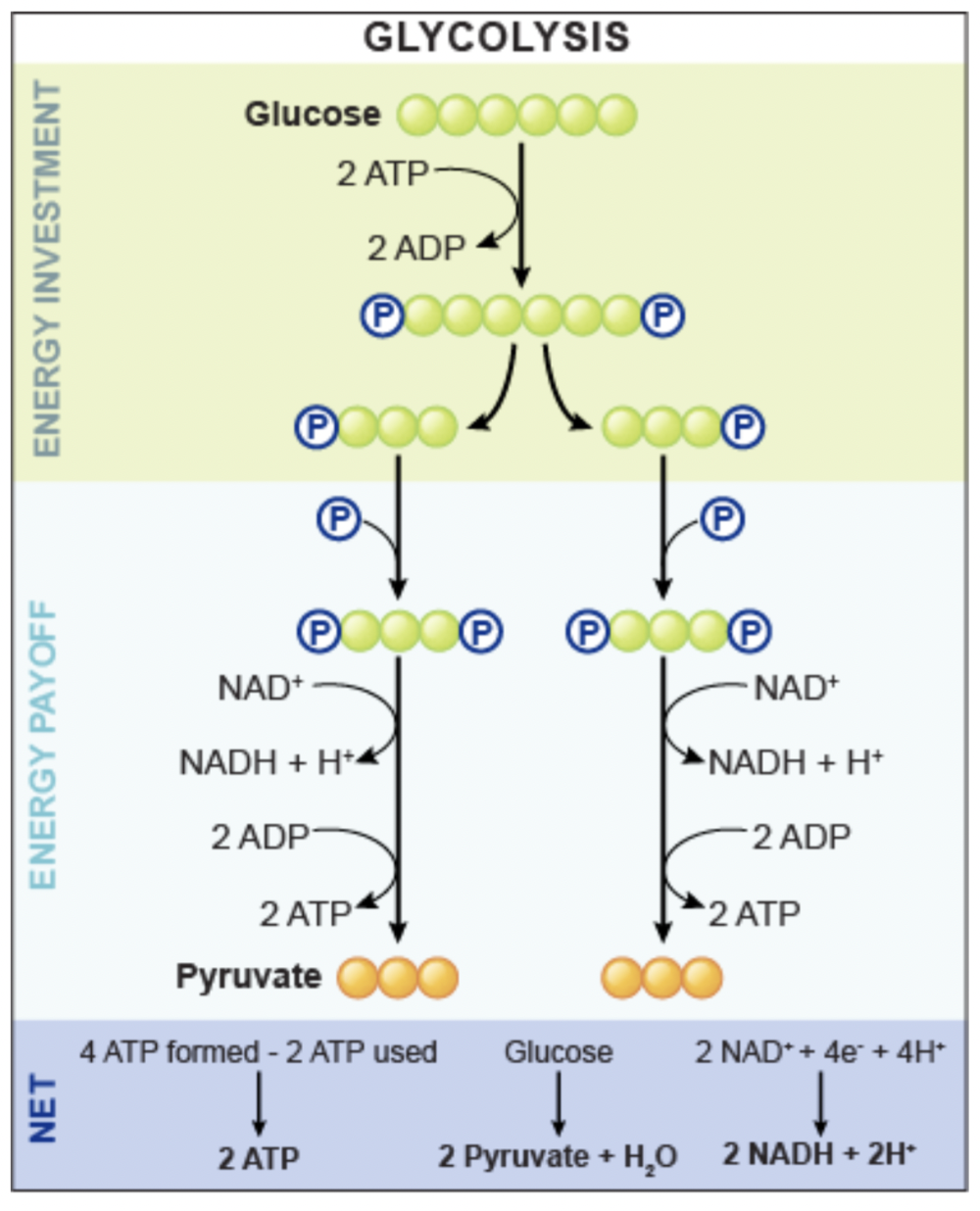
Glycolysis: Take place?
Cytoplasm
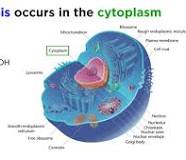
Glycolysis: the net production of ATP from each glucose
2 ATP Molecules (from each molecule, 4 total)
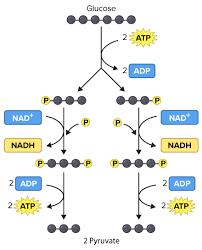
Glycolysis: role of NAD+ and NADH
NAD+ acts as an electron carrier that gets reduced to NADH, allowing the pathway to continue enabling energy and electron transfer.
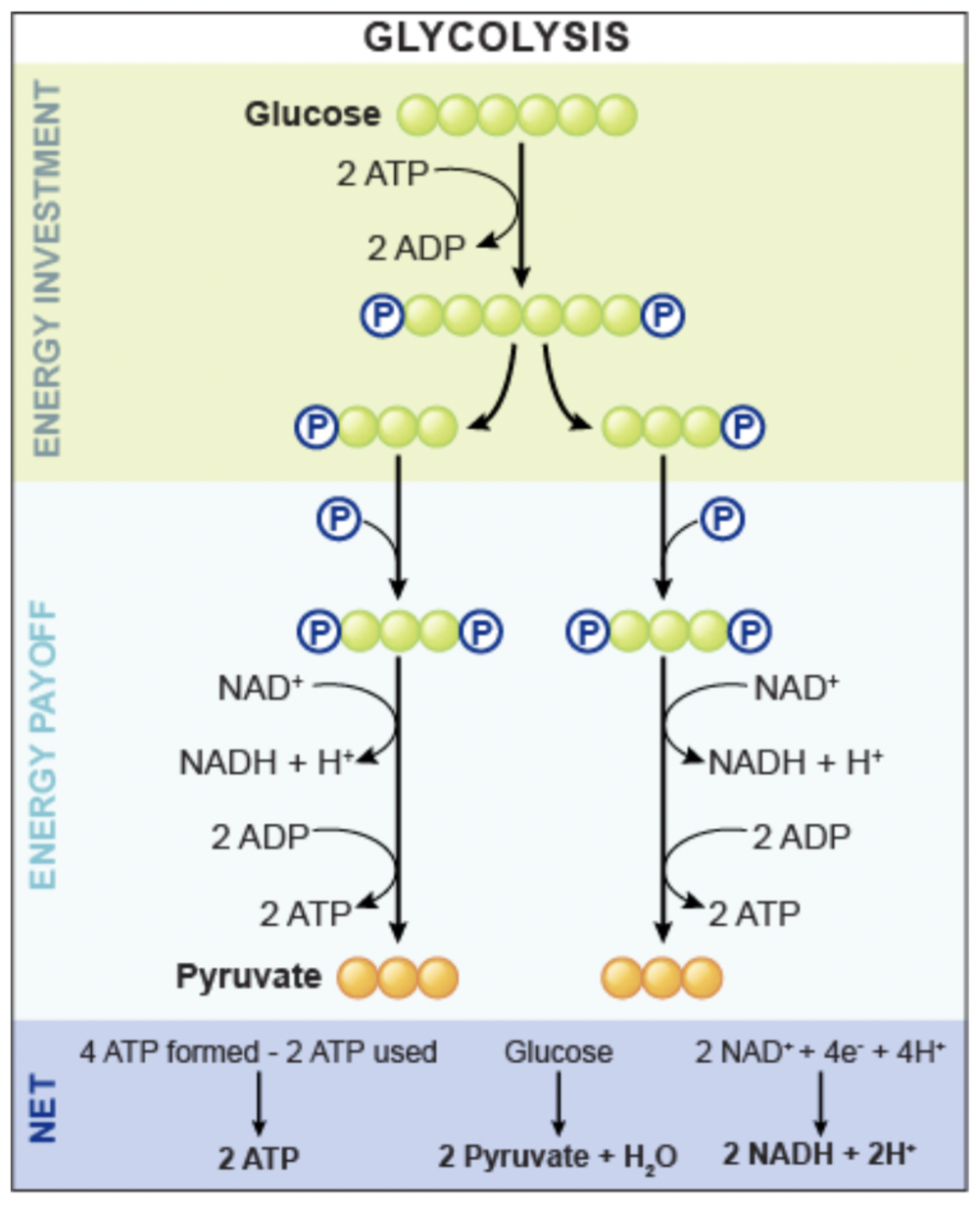
What happens to glucose during glycolysis
Glucose is oxidized into pyruvate.
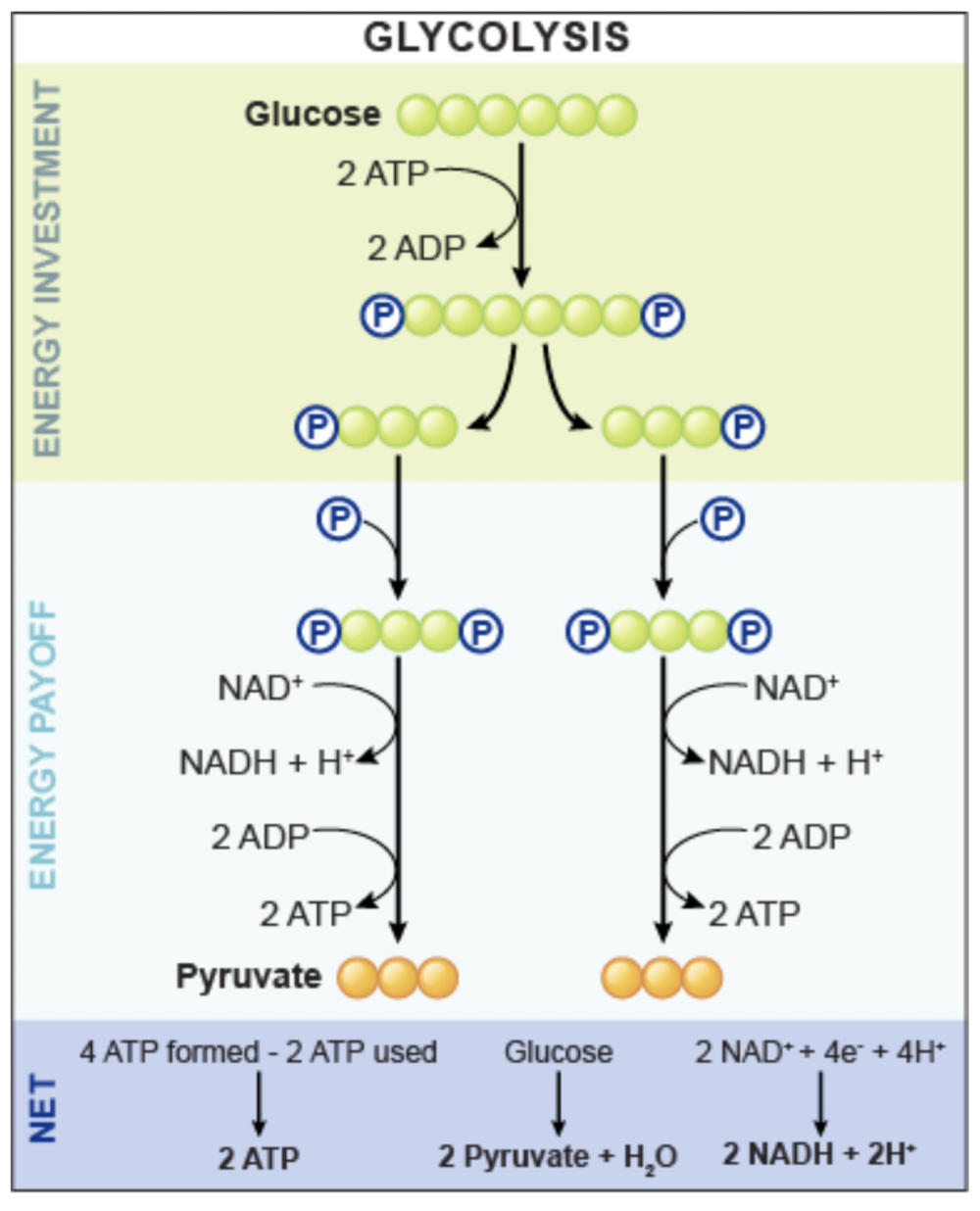
What is the process of glycolysis?
A 6-carbon glucose is split into two 3-carbon molecules of pyruvate.
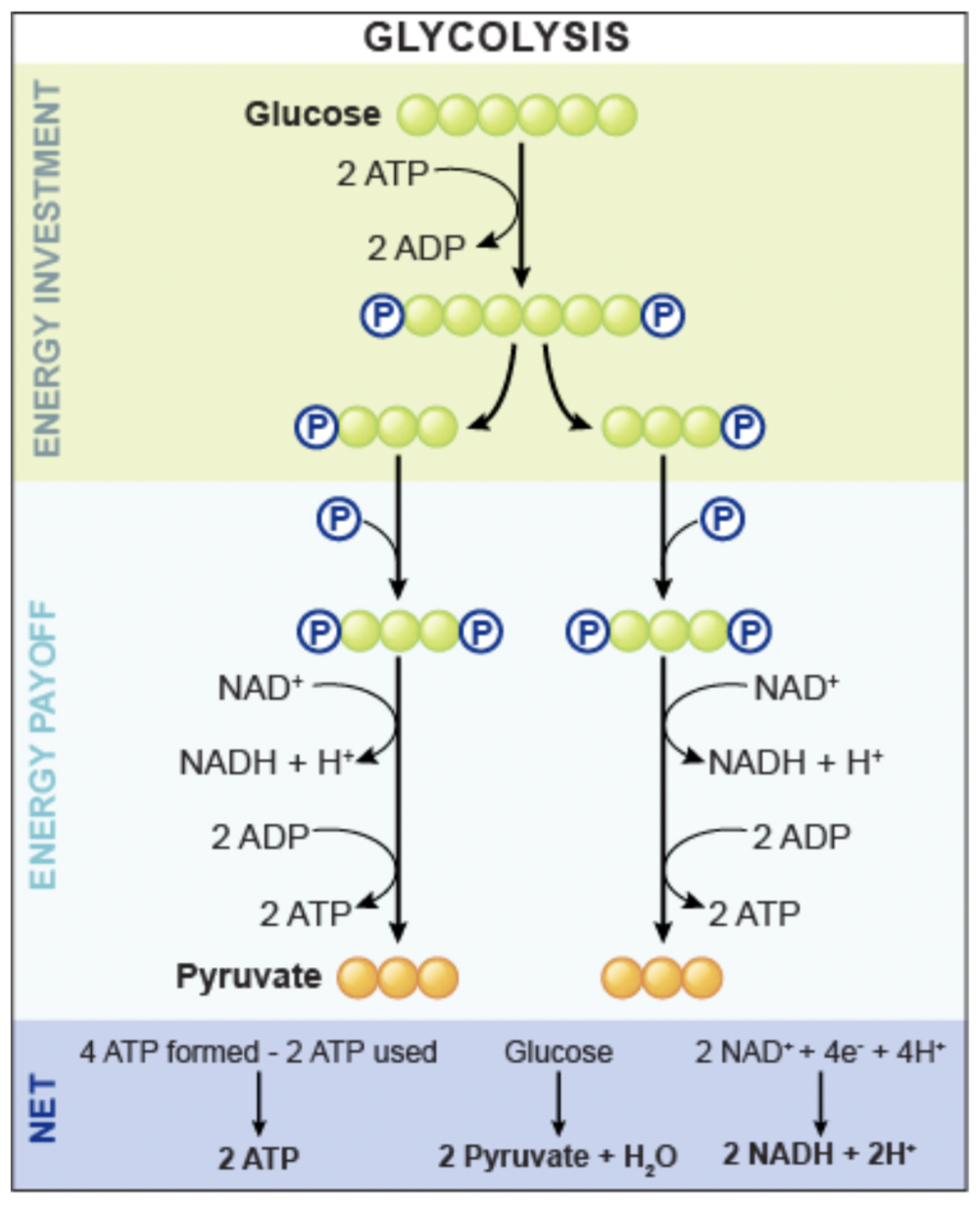
What molecules carry energy away from glycolysis?
ATP, NADH, and pyruvate
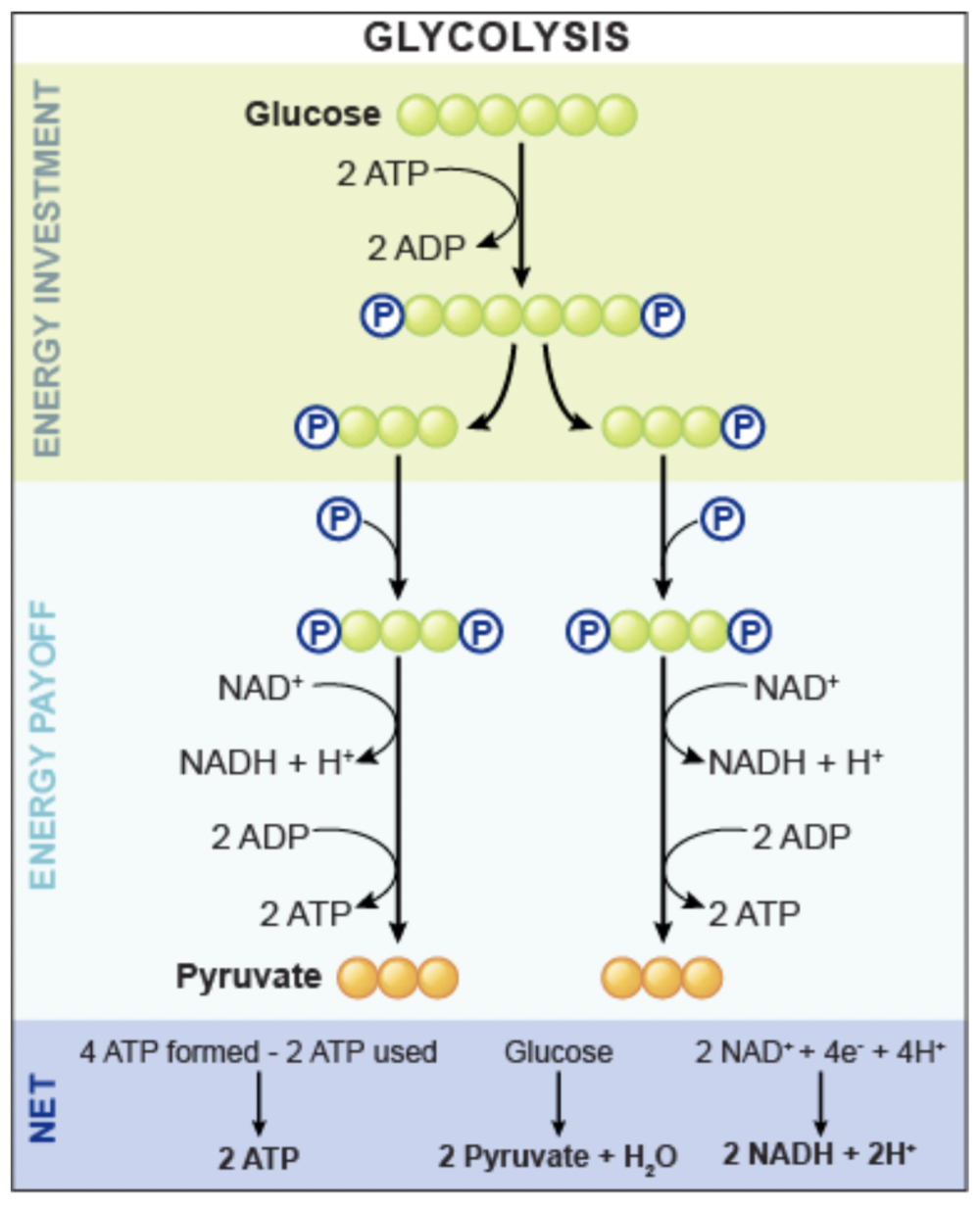
Second stage of cellular respiration
Oxidation of pyruvate to acetyl-CoA
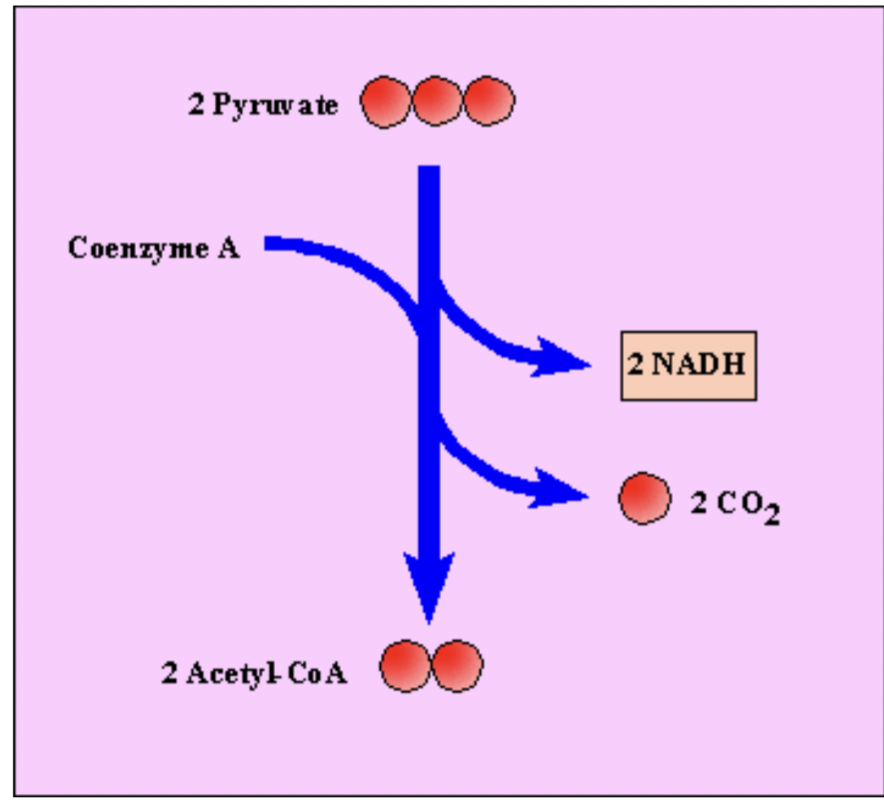
What happens to NAD+ during pyruvate oxidation
NAD+ is reduced to NADH
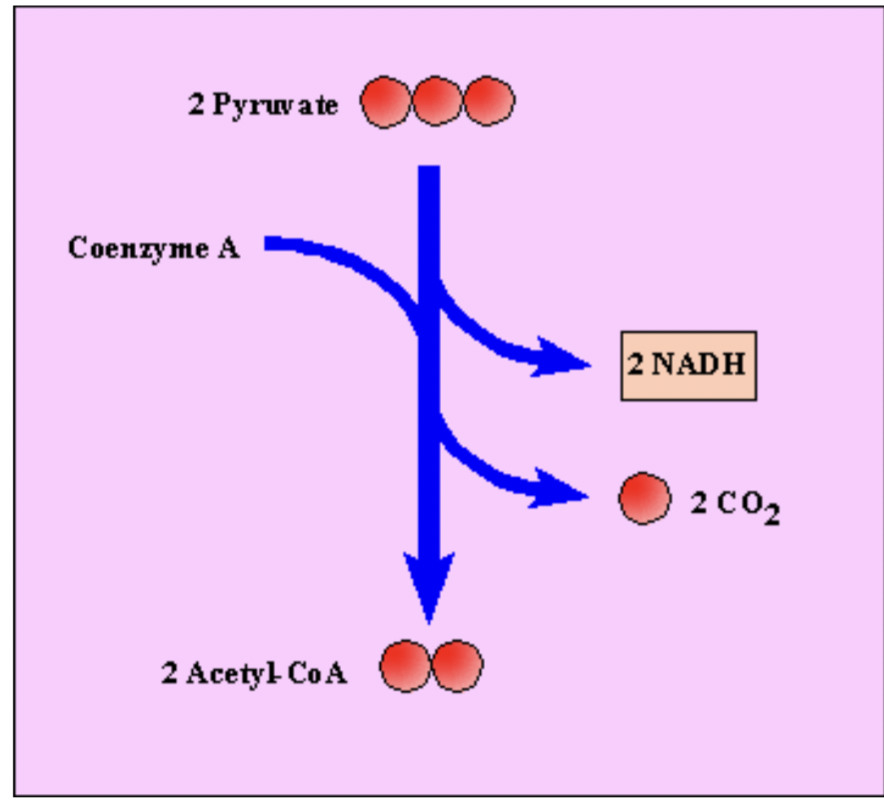
What happens to pyruvate during oxidation of acetyl-CoA
Pyruvate is oxidized and one carbon dioxide (Co2) is formed through the decarboxylation of each pyruvate molecule.
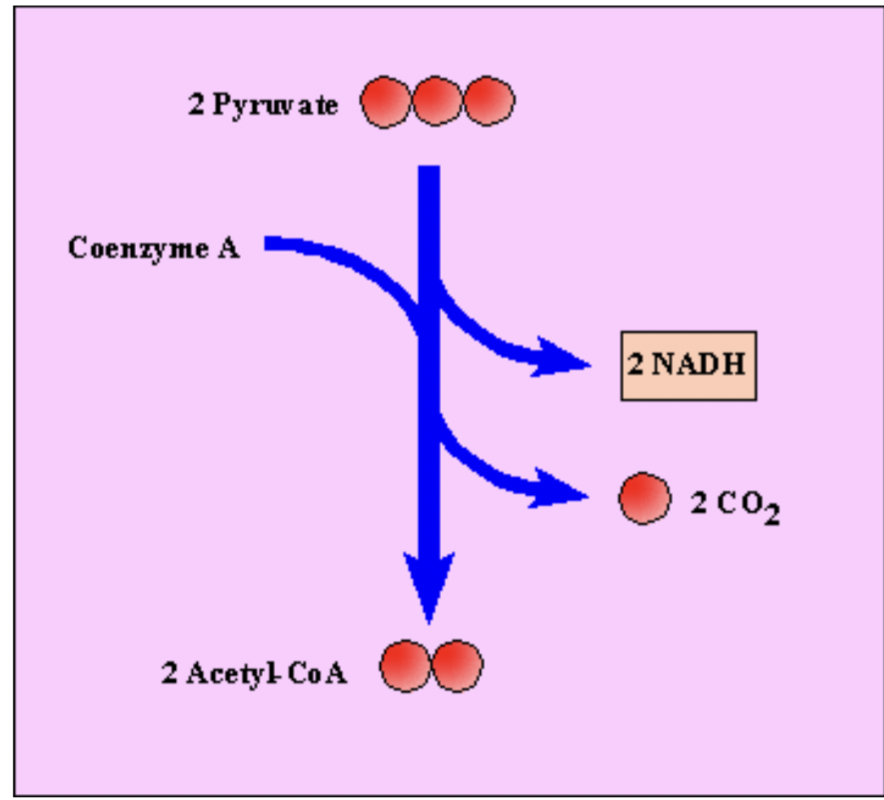
What waste product is released during pyruvate oxidation
Carbon Dioxide (Co2)
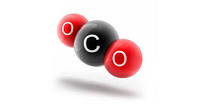
What molecule is added to pyruvate to form acetyl-CoA
coenzyme A (CoA)
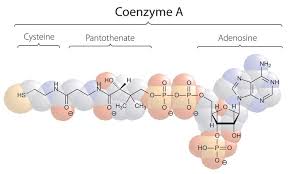
Where does the Krebs cycle take place?
mitochondria
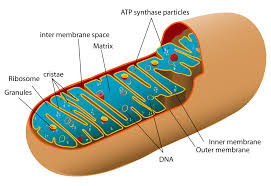
what makes the citric acid cycle a cycle:
oxaloacetate is the exact molecule needed to accept a acetyl- CoA and start the cycle again
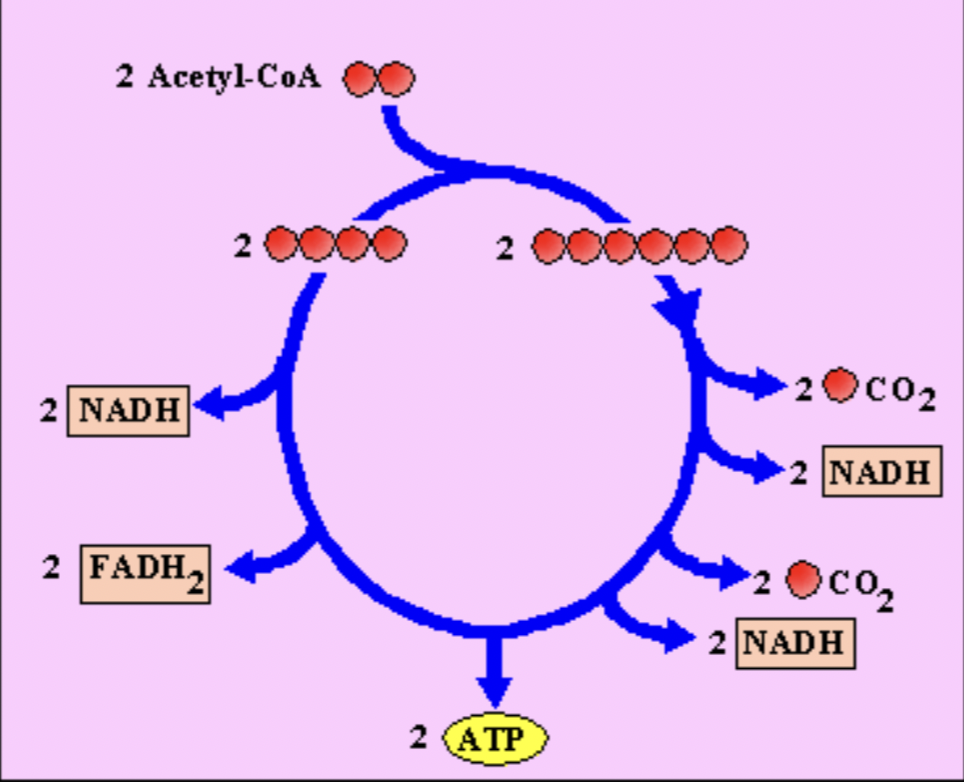
What is the first step of the Krebs cycle
Acetyl-CoA (2C) bonds with oxaloacetate (4C) to form citric acid (6C).
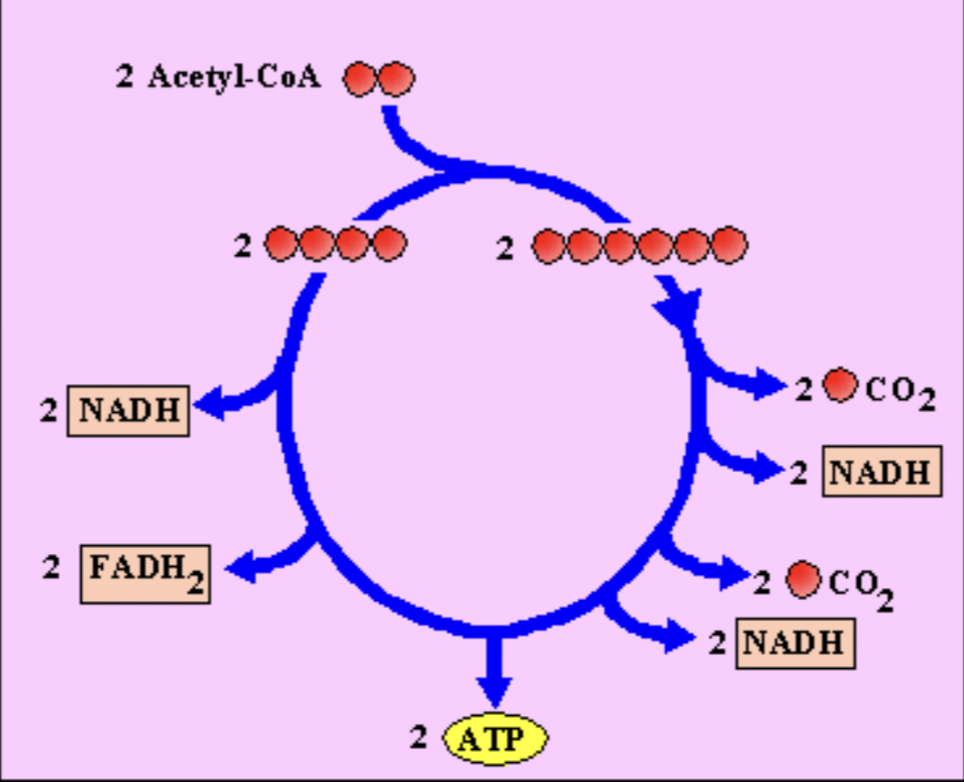
What happens to the two carbons from Acetyl-CoA?
They are released as carbon dioxide (Co2)
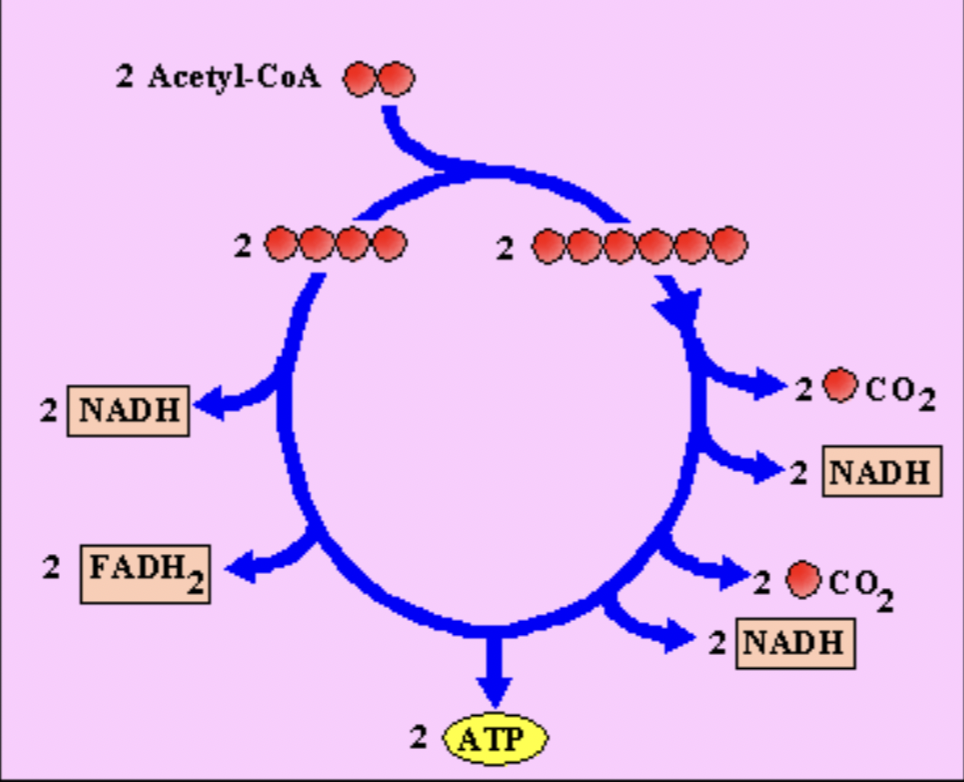
What molecules are reduced during the Krebs cycle?
NAD+ is reduced to NADH, and FAD is reduced to FADH2.
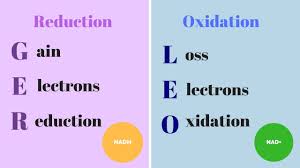
What happens to the carbon compounds during the Krebs cycle?
They are oxidized.
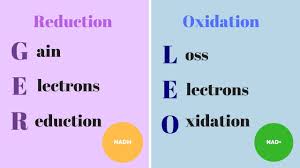
What process provides high-energy electrons for the electron transport chain.
The reduction of NAD+ and FAD during the Krebs cycle.
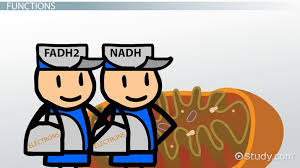
What molecule is regenerated at the end of the Krebs cycle?
Oxaloacetate
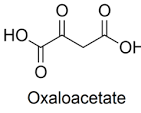
What energy molecule is produced directly in the Krebs cycle?
A small amount of ATP (from ADP phosphorylation)
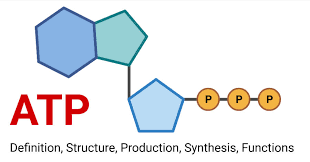
Where does the electron transport chain take place in the mitochondria.
In the Inner membrane
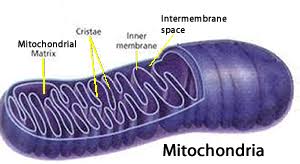
What are the folds of the inner mitochondrial membrane called and do?
Cristae, this increases the surface area which is good for producing more energy at a faster rate

What molecules carry electrons to the ETC?
NADH and FADH2
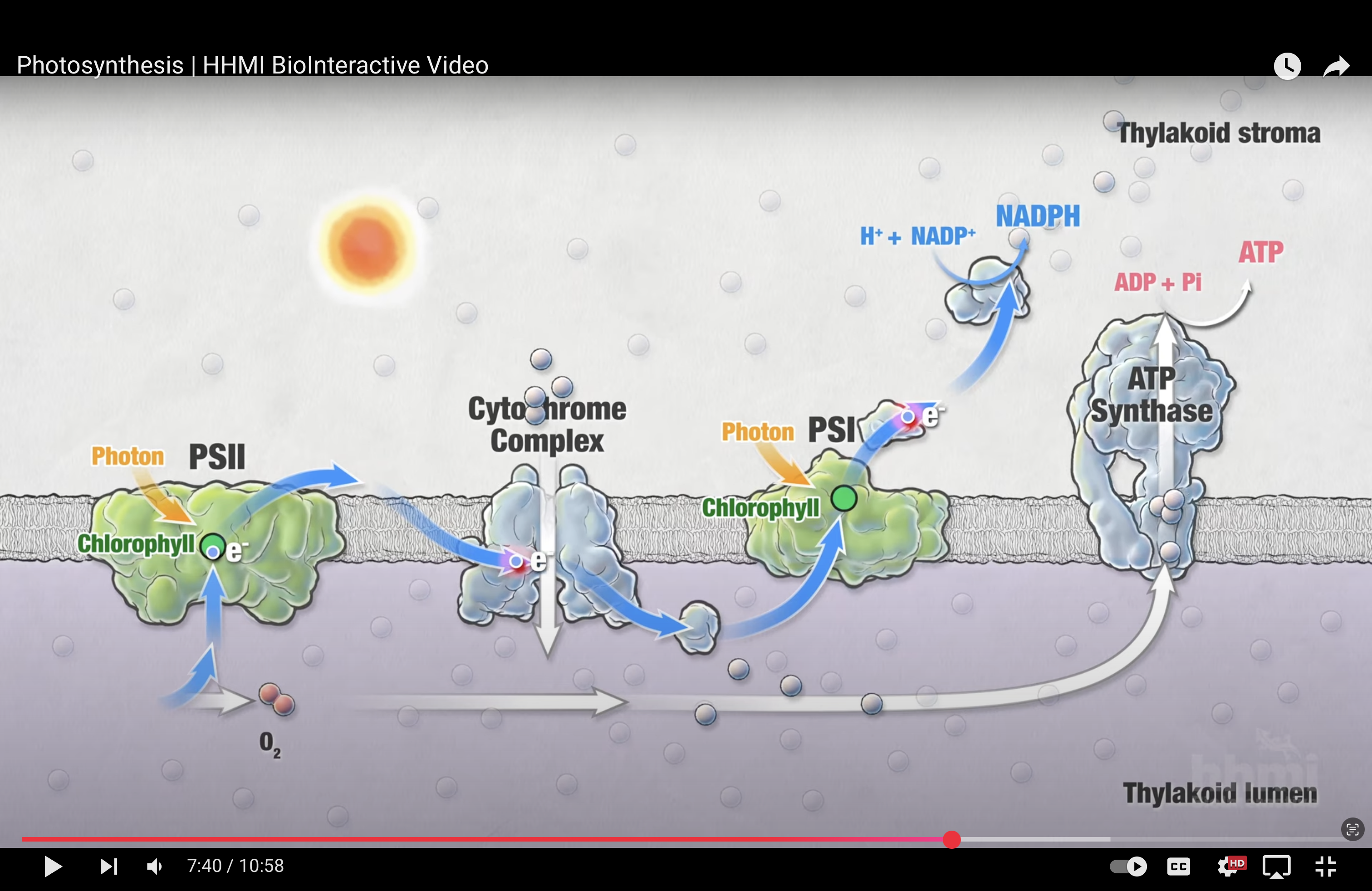
What happens to the electrons as they move down the ETC?
They go through redox reactions, releasing energy.
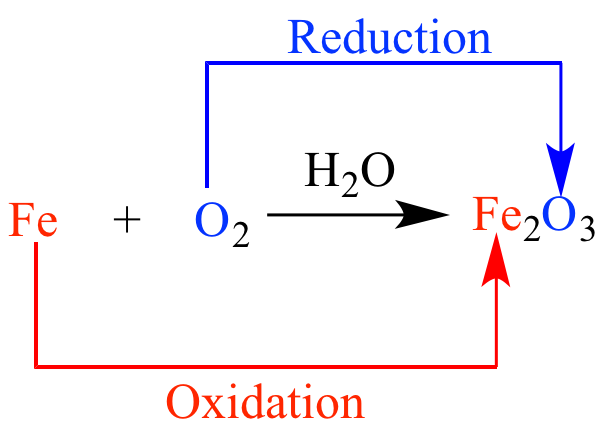
What is pumped into the inter membrane space during ETC?
Hydrogen Ions (H+)
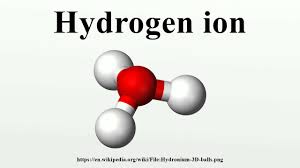
What does the H+ gradient do?
It stores potential energy used to make ATP.
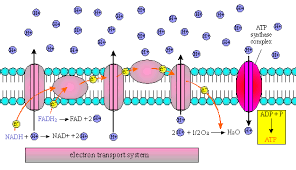
What enzyme used the H+ gradient to make ATP?
ATP synthase
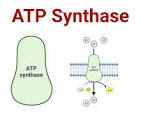
What happens at the end of the ETC?
Oxygen is reduced (H2O) and acts as the final electron accepter.
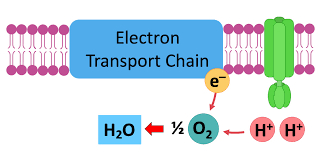
Explain why cyanide is a poison
Cyanide is a poison because it blocks cells from using oxygen by inhibiting a key enzyme in the mitochondria, leading to cell death
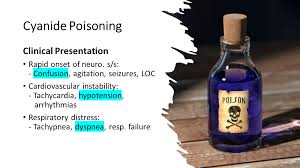
Outline the process of lactic acid fermentation
glucose is broken down into pyruvate through glycolysis. Pyruvate is then converted to lactic acid, regenerating NAD⁺, which allows glycolysis to continue producing small amounts of ATP without oxygen
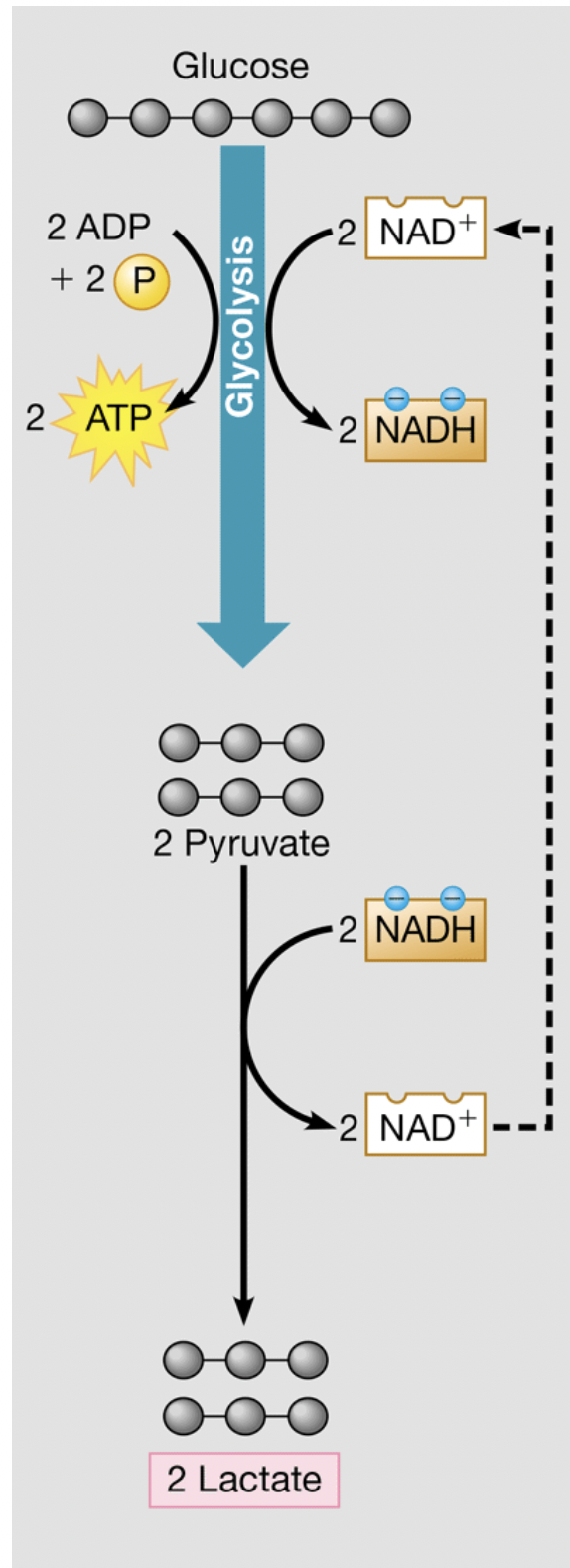
Outline the process of alcoholic fermentation
glucose is broken down into pyruvate through glycolysis. Pyruvate is then converted into ethanol and carbon dioxide in two steps:
Pyruvate is decarboxylated to acetaldehyde, releasing CO₂.
Acetaldehyde is reduced to ethanol, regenerating NAD⁺, which keeps glycolysis going to produce ATP.
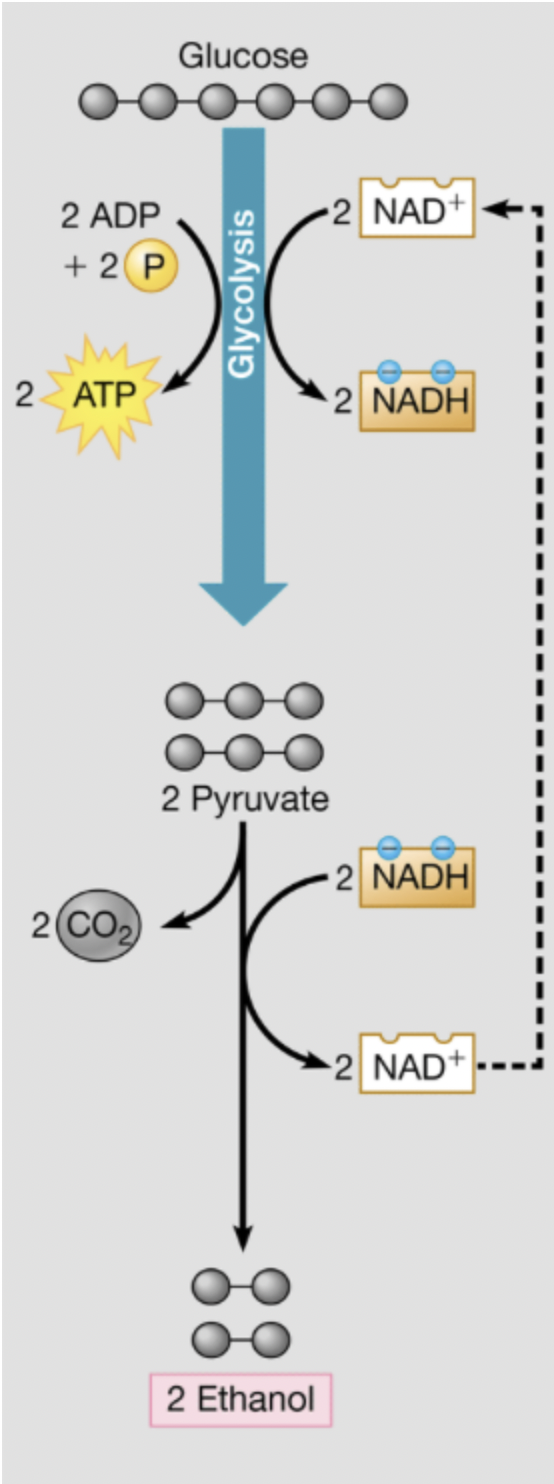
Where does fermentation takes place in a cell
Cytoplasm
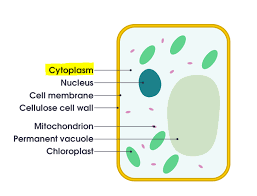
Compare aerobic respiration and fermentation in terms of energy transferred/ ATP produced
Aerobic respiration produces significantly more energy, generating up to 36-38 ATP per glucose molecule. It uses oxygen and completely breaks down glucose into carbon dioxide and water.
Fermentation, on the other hand, produces much less energy, yielding only 2 ATP per glucose molecule, as it only relies on glycolysis and does not fully break down glucose.
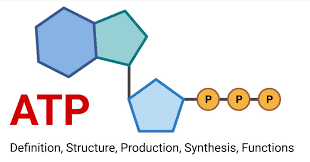
Outline several examples of organisms/cells that use fermentation, including mammal muscle cells
Mammal muscle cells: During intense exercise, when oxygen is limited, muscle cells use lactic acid fermentation to produce ATP, leading to lactic acid buildup and muscle fatigue.
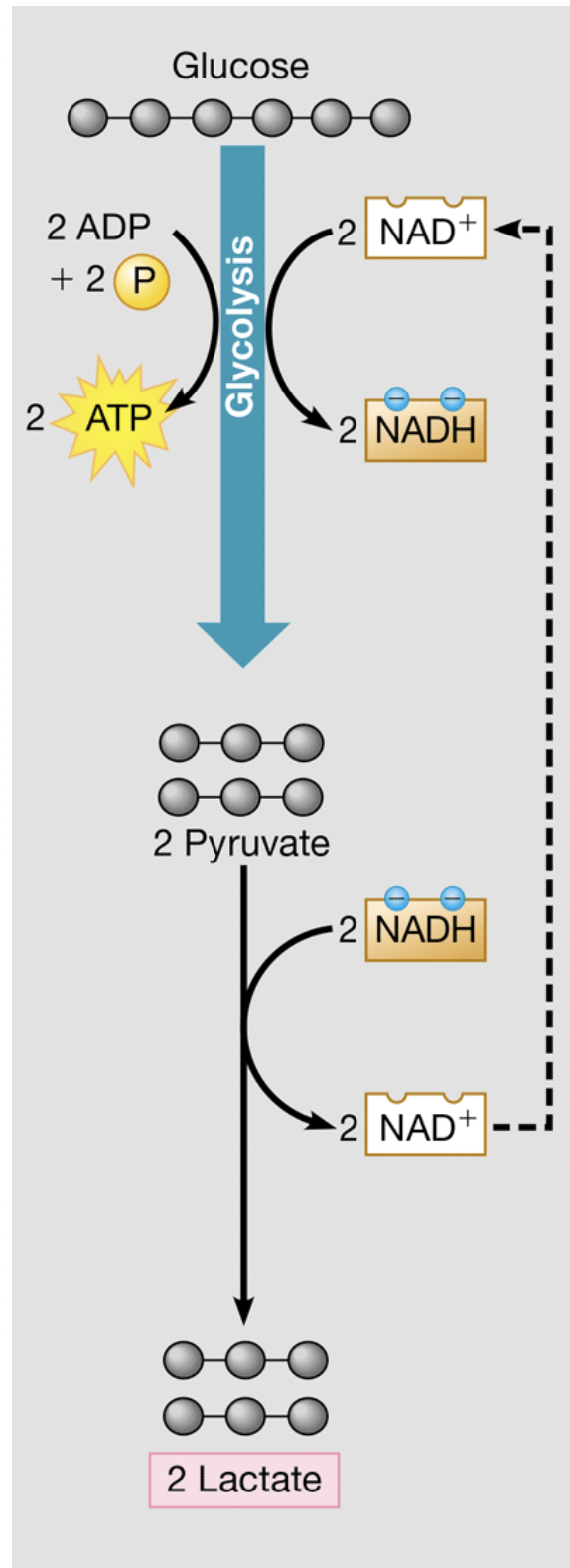
Outline several examples of organisms/cells that use fermentation, including yeast.
Yeast: Yeast performs alcoholic fermentation, converting glucose into ethanol and carbon dioxide. This process is used in baking (to make bread rise) and brewing (to produce alcohol).
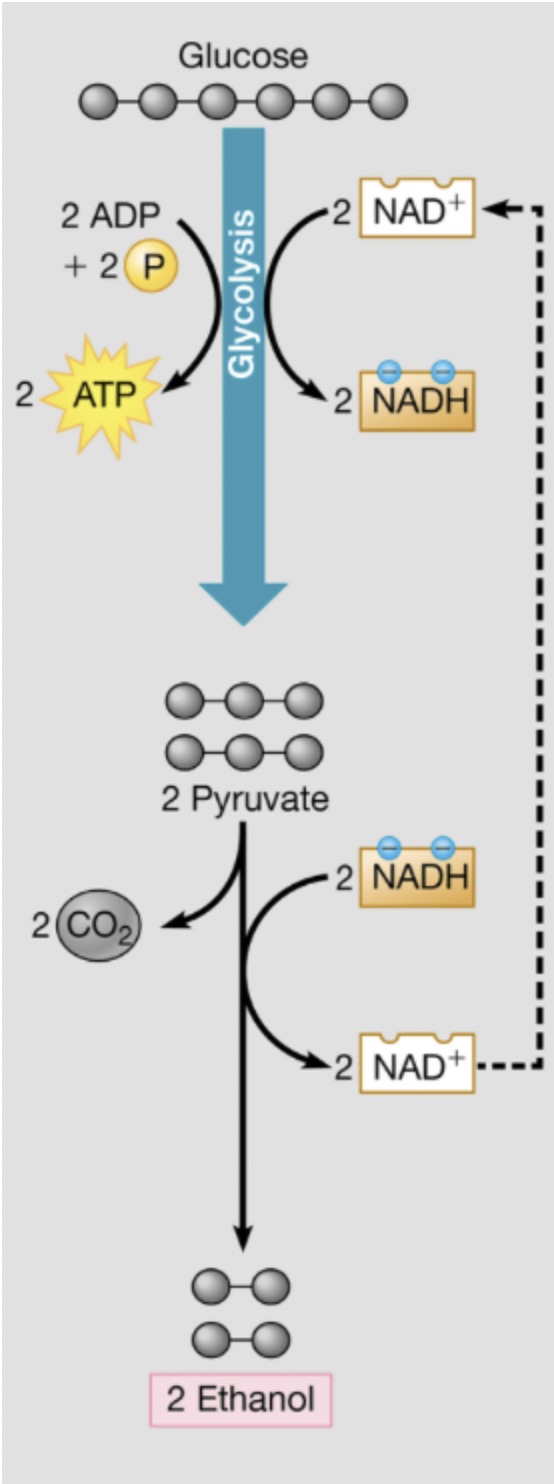
Outline several examples of organisms/cells that use fermentation, including some bacteria.
Bacteria:
Lactic acid bacteria (e.g., Lactobacillus) use lactic acid fermentation to produce lactic acid, which is important in making yogurt and cheese.
Some bacteria (e.g., Clostridium) use mixed acid fermentation, producing a variety of products like acetic acid, ethanol, and gases.
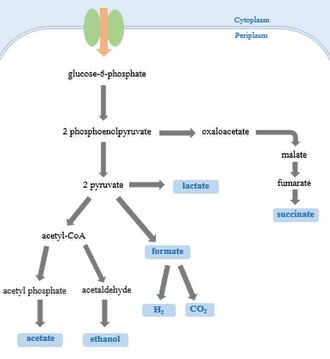
evolution
Changes in genetic populations that can give rise to new species from a common ancestor. Populations evolve, not individuals.
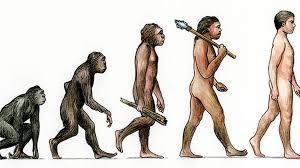
phylogeny
Trace patterns of shared ancestry between lineages. Each lineage has a part of its history that is unique to it alone and has parts that are shared with other lineages.
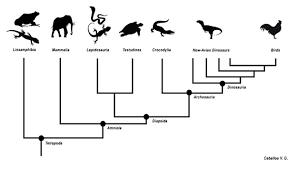
clade
Grouping that includes a common ancestor and all the descendants (living and extinct) of that ancestor.
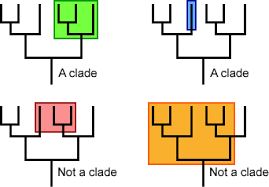
1st Major Clade
Bacteria: single celled prokaryotic organisms
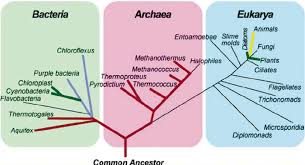
2nd Major Clade
Archaea: single celled prokaryotic organisms, but genetically and biochemically distinct from bacteria. (Lives in extreme environments)
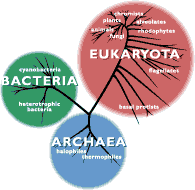
3rd Major Clade
Eukarya: organisms with eukaryotic cells (cells with nucleus) including plants, animals, fungi, and protists.
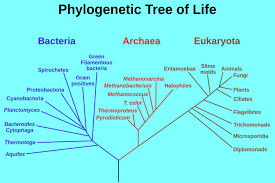
Explain how phylogenetic trees are constructed and used to represent ancestral relationships.
by examining shared traits, both morphological and genetic, to infer evolutionary relationships between species. They represent the evolutionary history of organisms, showing how they diverged from common ancestors.
Common Ancestor
An organism from which two or more different species are thought to have evolved
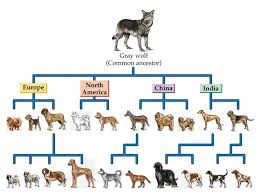
Explain how phylogenies are like a tree and not a ladder
because they show evolutionary relationships and divergence, unlike ladders that suggest a linear, hierarchical relationship.
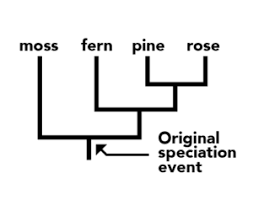
Construct a phylogenetic tree/ cladogram using shared derived characteristics (morphological, molecular, etc.).
Morphological= structure of organisms + features (bones)
Molecular= relating to molecules (DNA sequences)
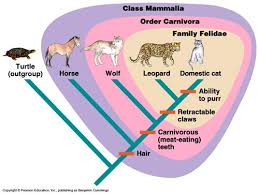
Homologies
Homologous structures: share a common ancestry, resulting in similar structures with potentially different functions. (bones in animals that have different functions, ex; humans, bats and whales)
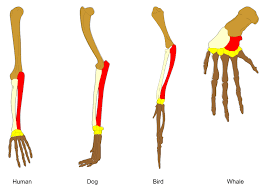
Analogies (Covergent evolution)
Analogous structures: arise from convergent evolution, where different species develop similar structures independently due to similar environmental pressures or needs, despite not sharing a recent common ancestor. (Wings of insects or birds, which both serve for flight but evolved independently).
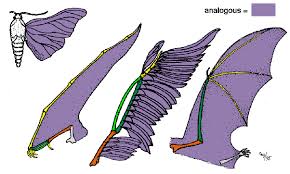
Vestigial
Vestigial structures: structures that used to be important but are no longer necessary for survival. (Tailbone, at one point it may have been needed but not anymore).
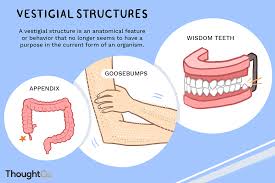
Divergent Evolution
when related species evolve different traits due to varied environments or selective pressures.
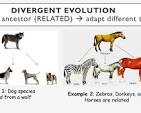
Covergent Evolution
when unrelated species evolve similar traits because they adapt to similar environments or ecological niches.
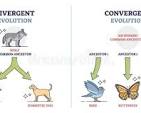
Outline how phylogenetic trees are used for classification
They classify organisms by visually showing their evolutionary relationships, grouping them based on shared ancestry and divergence patterns

Outline how time and extinctions are represented on evolutionary trees.
Time is shown on trees along the axis, with the base as the earliest point and branching indicating speciation; extinction are represented by branches that end before the present.
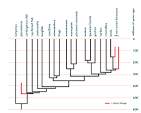
Mutation
A mutation is a change in the DNA sequence of an organisms genome, which can lead to variations in traits, some of which may be beneficial, neutral or harmful.
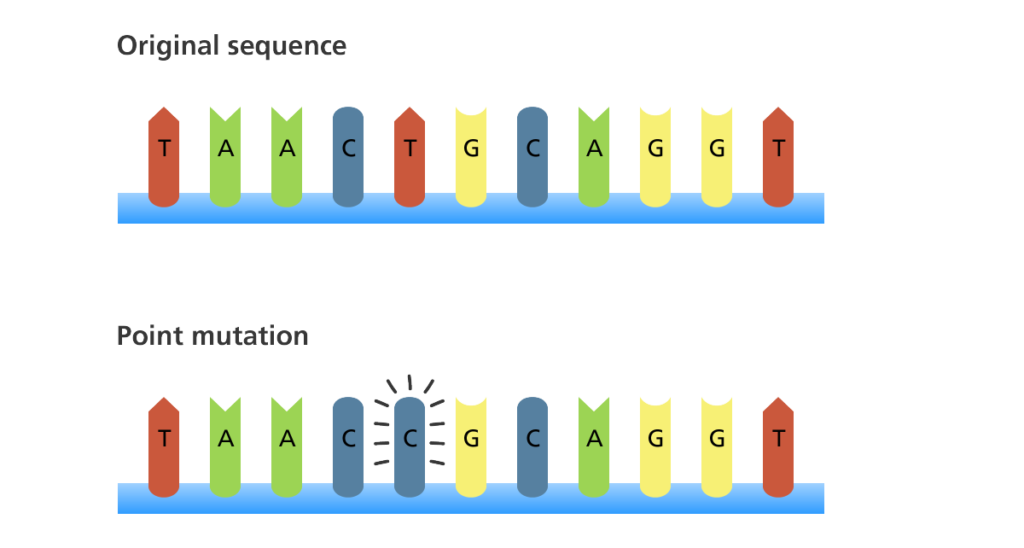
Migration (Gene Flow)
the movement of genes in (immigration) or out (emigration) of a population. Can happen through movement of individuals or gametes that can bring new alleles into a population.
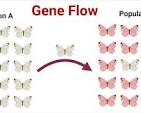
Genetic Drift
change in the frequency of an allele in a population. It occurs due to chance by bottleneck effect (if population is wiped by natural disaster a change in alleles will occur) and founder effect (If a small proportion of the original population establishes a new population or colony, it may have a different allele frequency)
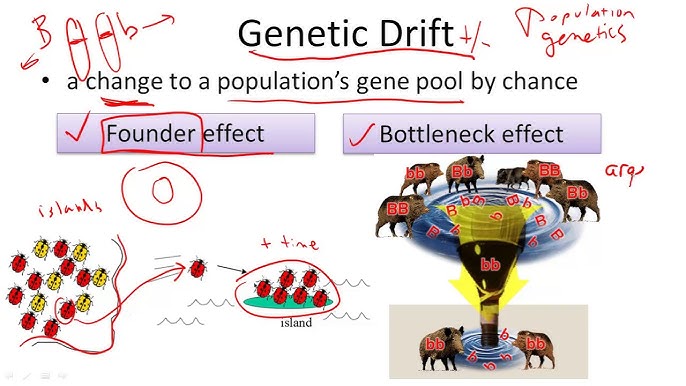
Natural selection
process which organisms with traits that better enable them to adapt to their environment tend to survive and reproduce in greater numbers, passing on these advantageous traits to future generations.
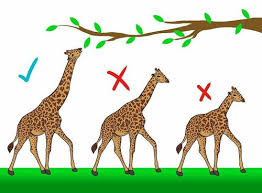
Explain how mutation, gene flow (migration) and sex produce genetic variation
Mutation introduces new alleles, gene flow mixes alleles between populations, and sex recombines alleles, all increasing genetic variation.
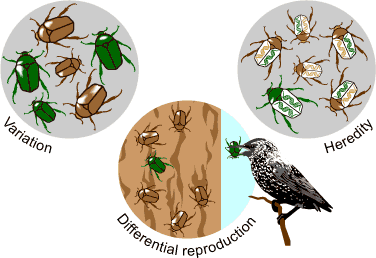
List the elements that make up carbohydrates
Carbon (C), Hydrogen (H), Oxygen (O)
Recognize the structural formula of the ring structure for glucose, a monosaccharide
Outline the importance of glucose to organisms
Glucose is the primary energy source, fuels cellular respiration to produce ATP and brain function, and metabolic fuel. Also, in photosynthesis its made and used for growth and storage.
Explain the relationship among monosaccharides, disaccharides and polysaccharides
Monosaccharides are simple sugars, disaccharides are two linked monosaccharides, and polysaccharides are long chains of monosaccharides. They build on each other, serving as energy sources and structural components.
Recognize the basic structure of disaccharide and polysaccharides
Explain how disaccharides and polysaccharides are formed and broken down.
Disaccharides and polysaccharides form through dehydration synthesis, removing water to link monosaccharides. They break down by hydrolysis, adding water to split them into simpler sugars
Outline the roles of the polysaccharides starch, glycogen and cellulose
They r polysaccharides with diff roles. Starch: Plant energy storage. Glycogen: Animal energy storage. Cellulose: Plant structure, indigestible by humans.
Autotroph
Autotroph: organism that produces its own food using light (photosynthesis) or chemical energy (chemosynthesis). EX: plants, algae, and some bacteria.
Heterotroph
Heterotroph: Organisms that get energy from food by consuming other organisms. EX: animals, fungi, most bacteria.
Label the structures of a chloroplast
Grana, thylakoid, thylakoid membrane and space, stroma.
Outline how isotopes have been used to trace the path of photosynthesis
Carbon- 14 and oxygen-18 are used to trace photosynthesis by tracking the movement of carbon and oxygen. Carbon-14 shows how carbon enters glucose, while oxygen-18 traces the oxygen released from water.
State the overall equation for photosynthesis
6CO2 + 6H2O + light energy --> C6H12O6 + 6O2
Explain how redox reactions are important in photosynthesis
Involve the oxidation of water (losing electrons) and the reduction of NADP+ to NADH. These electron transfers help convert light energy into chemical energy for glucose production.
Explain how pigments (like chlorophyll) are involved in photosynthesis
Chlorophyll absorbs light energy (mainly blue and red) and initiates the light dependent reactions in photosynthesis, producing ATP and NADPH for glucose production.
Describe the overall process of photosynthesis including the light reaction and Calvin Cycle
Photosynthesis converts light energy into glucose.
Light reactions: Chlorophyll absorbs light, splits water, and produces ATP and NADPH
Calvin Cycle: ATP and NADPH convert carbon dioxide into glucose
Explain the processes of the light reaction
Explain how photosynthesis moderates global climate change.
Helps by absorbing carbon dioxide (CO2), reducing greenhouse gases in the atmosphere. Plants and oceans act as carbon sinks, storing CO2 and slowing global warming.
Compare and contrast photosynthesis and cellular respiration
Photosynthesis: Converts light energy into glucose, using CO2 and H20, and releasing O2. It occurs in the chloroplasts of plants.
Cellular Respiration: breaks down glucose to produce ATP, using O2 and releasing CO2 and H20. It occurs in the mitochondria of animals.
They are opposite processes: photosynthesis stores energy, while respiration releases it.
State the wavelengths and colors of light most effective for photosynthesis
most effective: Blue (400-500m) and Red (600-700m) light. Blue light boosts vegetable growth, while red drives photosynthesis. Green light is less effective because it is mostly reflected.
Explain the roles of NADP+ and NADPH
NADP+ accepts high energy electrons in the light reactions, forming NADPH, which then delivers those electrons to the Calvin cycle for glucose production.
Outline how light energy (as photons) is converted to the energy of excited electrons (include the roles of photosystem II, photosystem I and chlorophyll)
Light excites chlorophyll in Photosystem ll, boosting electrons through the electron transport chain, generating ATP. Photosystem l re-excites electrons, which are then used to form NADPH for the Calvin cycle.
Explain water's role in the light reaction
In the light reaction, water undergoes photolysis in Photosystem ll, providing electrons to replace the lost, releasing O2, and supplying H+ ions for ATP synthesis.
Explain how ATP is produced in the light reactions, including the role of the proton gradient, chemiosmosis and photophosphorylation
In the light reactions, electrons moving through the ETC pump H+ ions into the thylakoid lumen, creating a proton gradient. Through chemiosmosis, H+ flows back via ATP synthase, driving photophosphorylation, which converts ADP + Pi into ATP for the Calvin cycle.
Explain how the energy of ATP and NADPH are used to synthesize G3P from carbon dioxide in the Calvin cycle (carbon fixation)
In the Calvin cycle, ATP powers reactions, and NADPH donates electrons to convert CO2 into G3P. RuBisCO fixes CO2, forming G3P. ATP also regenerates RuBP to continue the cycle.
Explain the role of RuBP and rubisco in the Calvin cycle
RuBP binds CO2 to start carbon fixation in the Calvin cycle, while RuBisCO catalyzes this reaction, forming G3P. RuBP is regenerated to sustain the cycle.
Explain what makes the Calvin cycle a cycle
because RuBP is regenerated, allowing continuous CO2 fixation and sugar production.
Blending Hypothesis
idea that the hereditary materials contributed by the male + female parents mix in forming the offspring, similar to the way that blue and yellow paints blend to make green. (False)
Contributions of Gregor Mendel to the study of genetics
Through his experiments with pea plants, is considered the "father of genetics" for discovering the fundamental laws of inheritance, including the laws of segregation and independent assortment, which laid the foundation for modern genetics.
true-breeding
organisms that, when self-fertilized or bred with another of the same variety, produce offspring that are identical to the parent for a specific trait
hybrid
offspring of two organisms

P generations
refers to the parent individuals from which offspring are derived in studies of inheritance; P stands for parental.
F1 generation
refers to the first filial generation, which consists of the hybrid offspring resulting from a cross between two parental (P generation) individuals
F2 generation
refers to the second filial generation, which consists of the offspring resulting from the self-fertilization or cross-fertilization of F1 generation plants.
